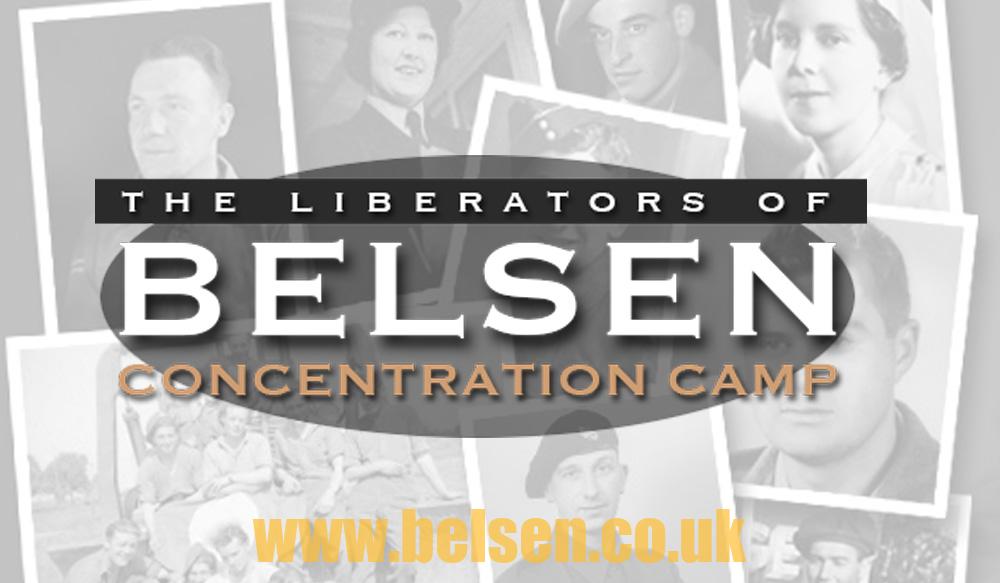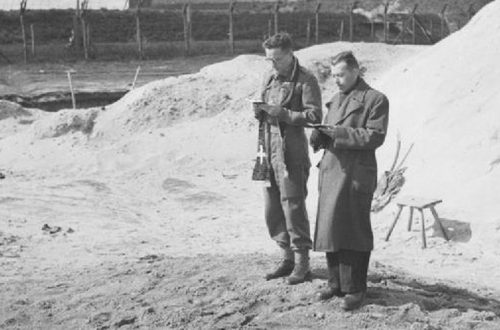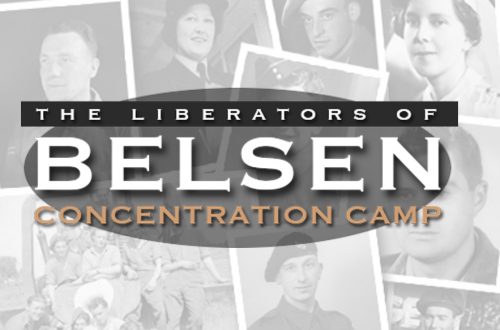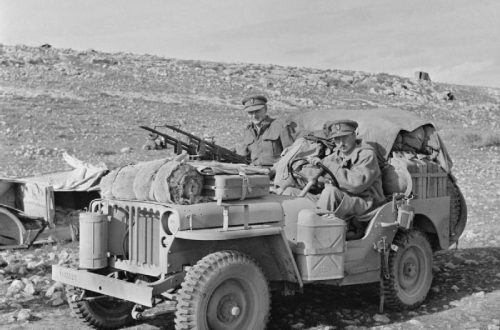
Frontline – Memory of the Camps
MEMORY OF THE CAMPS Original Airdate: May 5,1985Transcript.
Introduction
Fifty one years ago camera crews with the British and American armies entered the Nazi death camps and filmed the horror they found there. For decades that film was stored in the archives of the Imperial War Museum in London. The documentary was unfinished with missing sound tracks. But the directors, including Alfred Hitchcock, had developed a script to go with the pictures. Tonight, FRONTLINE presents that film unedited, as close as possible to what the producers intended over a half-century ago. They made it as a document to serve our collective memory.
TREVOR HOWARD
In March 1933, 17,264,296 Germans voted for the National Socialist Party; 20,680,000 others cast their vote for Democrats, Communists, Christian Socialists, People’s Party, etc., etc. Lack of unity among these parties opposing the Nazis proved fatal. The National Socialist Party was in power.
They made many claims and many promises.
The German people had embarked on that long, incredible journey that led seemingly out of chaos to unprecedented triumph. Promise after promise had been fulfilled. Austria 1938, Czechoslovakia 1938, Poland 1939, Norway, Denmark, and France in quick succession. A place in the sun at last. True, they had lost their trade unions and a lot of books had been burned, but it seemed a good sort of bargain, and one got to like being told what to do, having one’s views prescribed, especially if it meant a vista bright with the promise of grandeur and conquest.
In the spring of 1945, the Allies, advancing into the heart of Germany, came to Bergen Belsen. Neat and tidy orchards, well stocked farms line the wayside and the British soldier did not fail to admire the place and its inhabitants– at least until he began to feel a smell It came from a concentration camp, a waste ringed with barbed wire and overlooked by watchtowers. Coming in from the flowering countryside in spite of the frightful smell, things didn’t seem so bad at first; children smiled through the barbed wire and women laughed and waved their hands.
But Belsen camp was vast and inside was a different story. They had not eaten for six days and every soldier’s stock of food was called into use. Water, too, had been cut off and so the water cart was the most important thing to arrive. Most of the people seemed to be listless, beyond hope and astonishment. Hunger had probably affected them that way. We discovered that among this stench of disease and decay was something a bit worse than hunger. Moving vaguely on rickety skeleton legs, they were too ill to eat.
How grateful they were for a kindly word or gesture! What misery, to live amongst such unmentionable filth with scarcely the strength to pick the lice which inevitably swarmed over them. They seemed accustomed to the smell and the horror. They had seen all there was to see.
Huts were almost impossible to go near; they were full of tangled masses of people who had died slowly and painfully of starvation and disease writhing in agony, helpless in puddles of excrement.
It was difficult to imagine the orchards now, those rich fields where the stolid cattle cropped the juicy grass, for here, a few minutes away inside the barbed wire, was nothing but filth and death. Dead prisoners hurled out and stacked in twisted heaps. Dead women like marble statues in the mire. This was what these inmates had to live among– and die among.
The dead which lay there were not numbered in hundreds, but in thousands; not one or two thousand but 30,000.
Here is a pit where the inmates– in order to earn food– had to drag the bodies of their comrades, but they were too weak to keep up with the rate at which they were dying so the pit remains only half filled.
The S.S. Guards in charge of the camp were captured and lined up for examination. Their papers were gone through to confirm their status, their authority.
Each with his death’s head badge.
Each justified by German law.
They were unashamed, well-fed, well-dressed and cheerful.
There were women also on guard in Belsen. Volunteers who came of their own free will, to do their bit.
Not sickly pale with hollow faces and hungry eyes, but well-fed and well-kept with a strutting arrogance.
The commandant of the camp, Joseph Kramer, was removed for trial as a war criminal by an Allied Military Court.
There was an urgent need to get rid of as many bodies as possible, as quickly as possible, so all the S.S. were set to work.
Five hundred Hungarian troops, captured with the S.S., were started on a grave-digging operation. The S.S. themselves were made to do the unpleasant job they had forced the inmates to do.
This, after all, was nothing to these men, they, the “Master Race,” had been taught to be hard; they could kill in cold blood; and it seemed to the British soldier fit and proper that the killers should bury the nameless hopeless creatures they had starved to death.
The faces of the bystanders showed just a little of the hate that Germany has inspired– and some of the anguish, too.
Meanwhile, back at the camp, those who were still living were being attended to. Supplies of hot soup were prepared and those who could eat unaided were fed as quickly as possible.
There had been no water supply for six days, the Germans pleaded it had been cut. We laid on water in a few hours and before twelve hours had passed, had sufficient to enable them to wash.
Soap was provided, the first they had seen for months, and an orgy of washing ensued.
A mobile bath unit was set up and provided hot water for baths.
Inmates thought there was a snag at first– expected to be beaten for going near it probably, but when they learned that the dream was true! Hot water!
And these are the people the Nazis said delighted in being dirty.
But the job of clearing up Belsen was a big one.
The Burgermeisters and Civil Officials of the neighborhood were brought to witness the scenes that had been caused as part of the Nazi scheme of things. This is what they expected.
It had been happening for years, but they shrugged their shoulders and beat their brows and tried to say it had been none of their business; but they were mostly silent.
The S.S. men are not so spick and span now. Seven days of being shouted and cursed at and handling corpses by the hundred are beginning to tell.
After seven dreadful days, the funerals still go on. There seems to be no end.
PRISONER (translated)
My name is Doctor Fritz Klein. I’ve been in this camp for one-and-a-half years. I was born November 24, 1888; I’m 58 years old, a German from Rumania. I’m speaking today, the 24th of April 1945.
TREVOR HOWARD
They were given an address by a British officer through a loud speaker van.
BRITISH OFFICER (Translated)
You, who represent the fathers and brothers of German youth, see before your eyes, some of the sons and daughters who bear the direct responsibility for this crime. They are a small portion only. Therefore, it is more than the human soul is able to bear. But who bears the real responsibility? You, who allowed your leader to carry out this horrible madness; you, who couldn’t do enough for this degenerate triumph. You, who were a part of this camp….
TREVOR HOWARD
One might ask why all the inmates surviving were not removed out of the camp altogether to a large town, for example, where there would be feeding and housing facilities; the answer is simply the dread word– typhus.
A mobile bacteriological unit and all medical aid possible together with 90 medical students from London hospitals were rushed to the spot to deal with it.
Lack of soap and water brought lice to the inmates and lice carry typhus.
To get rid of typhus, one must first get rid of lice, so contaminated patients were removed from their huts and put through a “laundry” process. D.D.T. was dusted over them and they were washed clean, wrapped in blankets, and removed in clean ambulances by teams working in relays in a miracle of relief work.
Two miles away from the camp was found a large S.S. Panzer training school and hospital well stocked with medical supplies– strange that these should not have been used by the Germans for the inmates.
Scores still died every day: they were too far gone many of them to digest any food and there was a desperate shortage of nursing staff. Still, one could be thankful that they were not simply being left to rot away with neglect.
There were children, too, in Belsen camp, though what crime they had committed was difficult to imagine. Most of them had been saved by the women inmates who gave up what little food they could get to the children.
Meals for these children had always been few and far between, so they ate what food we gave them with infinite care– nothing could be more dreadful now than to lose a piece of potato or a drop of soup.
Clothes was another urgent problem, so an outfitting department was set up, and clothes gathered from shops in the surrounding towns, were soon being tried on and gossiped over as women love to do.
There was something symbolic about new clothes. New clothes meant renewed hope.
They donned them with pride.
Now, he can look forward to growing up to useful manhood.
There were more than 200 children under twelve years old found still alive in Belsen camp.
To these children, clean dry clothes and kind words from a stranger were strange, undreamed of, mysterious things.
Some had been born behind the barbed wire. In what circumstances, one dare not try to imagine.
Where are their parents?
Here perhaps?
Or here?
Or down here in this pit?
BRITISH SOLDIER
Today is the 24th of April 1945. My name is Gunner James William Illingworth and I live at Cheshire. I am present in Belsen camp doing guard duty over the S.S. men. The things in this camp are beyond describing. When you actually see them for yourself, you know what you’re fighting for here. A picture in the paper can’t describe it at all. We actually know now, what has been going on in these camps and I know, personally, what I’m fighting for.
REVEREND STRETCH
I’m the Reverend T.J. Stretch, attached as padre to the formation concerning this camp. My home is at Fishguard. My parish is at Holy Trinity Church Aberystwyth. I’ve been here eight days and never in my life, have I seen such damnable ghastliness. This morning we buried over 5,000 bodies. We don’t know who they are. Behind me you can see a pit which will contain another 5,000. There are two others like it in preparation. All these deaths have been caused by systematic starvation and typhus and disease, which have been spread because of the treatment meted out to these poor people by their S.S. guards and their S.S. chief.
TREVOR HOWARD
We shall never know who they were or from what homes they were torn. Whether they were Catholics, Lutherans, or Jews, we only know they were born, they suffered and died in agony in Belsen camp.
And so they lie, Jews, Lutherans, and Catholics– indistinguishable cheek-to-cheek in a common grave.
The living have been taken to a cleaner place.
The typhus infected huts are set afire.
Soon the fire will die, the smoke and ashes will drift away and grass will cover the place.
The barbed wire goes down.
The striped livery goes with it.
Do not imagine this was the only black spot that was uncovered in Germany. There were over 300 others.
No German can say he did not know about them. The whole world had heard of Dachau, for it was publicized by the Nazis as a model camp ever since its inception way back in 1933. On the 28th of February of that year, the Presidential Emergency Decree suspended the basic civil rights of the German people for an indeterminate period and so eliminated legal safeguards against arbitrary imprisonment.
Here were 32,000 men of every European nationality, including 5,660 Germans.
From the outside one might, at a casual glance, have seen nothing remarkable or horrifying, but Dachau was crammed with three or four times the number it was designed for.
Here, as at Belsen, men knew hunger, men became weak, men fell sick, until they died where they lay on the floor.
In the Hut 30, alone, there is recorded, for example, 72 deaths with 24 hours.
Every day the dead were taken from the huts.
Here, as at Belsen, there were many who were too weak to be saved, too sick to eat. Typhus was taking its toll and truck loads of wretchedness had to be somehow dealt with in the already overflowing hospitals.
Dachau had its own brothel for the use of guards and favored prisoners. As the women died, they were replaced by a fresh contingent from the women’s camp at Ravensbrueck.
This was not used as a bath house, but as a death chamber.
Batches of prisoners were marched in here to die.
When the chamber was full, the doors were shut and sealed, a man at the controls let in the poison gas and another batch of helpless victims screamed their lives out beyond the grill.
The gas chamber was conveniently placed next to the mortuary, and next to that was the crematorium.
These great ovens were constructed exclusively for the burning of large numbers of corpses.
In the last three months, official records show that 10,615 people were disposed of here. Their clothes were turned over to the Deutsche Textil und Bekleidungswerke G.M.B.H., a private corporation whose stockholders were S.S. officials, which reclaimed and repaired the garments– with the use of unpaid prison labor– and the re-sold them to the camp clothing depot for the use of new prisoners.
The prisoners arrived often in railway trucks. But, there had been no hurry to unload this one. They went away, leaving the prisoners to die of hunger and cold, and typhus.
We found them like this, frozen stiff in the snow alongside a public road. By some miracle, seventeen men were still alive. All the rest, about 3,000, were dead.
Germans knew about Dachau, but did not care.
In Buchenwald, there were about 80,000 of whom 34,000 were employed outside the camp in an armaments factory.
During the first week of April, 25,000 were removed by the Germans to other camps because of th approach of the Allied forces. When the camp was liberated on April 13th, 20,000 inmates remained.
African Negroes, Albanians, Austrians, Belgians, Brazilians, Canadians, Chinese, Croats, Czechs, Danes, French, Germans, British, Greeks, Dutch, Italians, Yugoslavs, Latvians, Letts, Norwegians, Mexicans, Poles, Rumanians, Spaniards, Swiss, Americans, and Russians.
Fifty-five thousand of them died because of this place. People were tattooed across the belly with slave numbers and forced to work on starvation diet. People were coldly and systematically tortured.
Here Schoker, the camp commandant said, “I want at least 600 Jewish deaths reported in the camp office every day.”
Thugs were appointed as overseers or block leaders.
There was no efficient distribution of food. One prisoner collected the rations for ten or fifteen men. Hunger and hopelessness turned some of them into beasts. Sometimes, a prisoner carrying rations back to the hut was waylaid and robbed by other prisoners. Sometimes, he ate the best part of the food himself. Sometimes, he sold it.
Corruption was fostered for it gave another excuse for killing.
All this seemed so remote from humanity, so far beyond the behavior of man. British Members of Parliament came, and saw, and were sick at heart.
It had to be seen to be believed.
German citizens were brought from Weimar. They had to see, too, to see what they had been fighting for, and we had been fighting against.
They came cheerfully, like sightseers to a chamber of horrors, for there indeed were some real horrors. If a prisoner had a curiously tattooed skin, it was taken from him. We can only hope he was dead when it was done. The skin was tanned and made into lampshades, etc.
These shrunken heads belonged to two Polish prisoners who had escaped and been recaptured.
Some of the visitors did not care for the sight and were assisted by ex-prisoners.
Ebensee is a holiday resort in the mountains. The air is clean and pure. It cures sickness and there is a sweetness about this place: a gentle peace.
In this place the Luftwaffe or S.S. Panzer officer on leave relaxes, eats well, breathes deeply, finds romance. Everything is charming and picturesque.
But the concentration camp had become an integral part of the German economic system, so it was here, too.
They were able to see the mountains, but what use are mountains without food.
Prisoners at Dachau and Buchenwald dreaded being sent here. To them, this place did not mean recuperation, only starvation, tuberculosis through slavery in an underground factory, and finally left to cough one’s life out unaided and crowded in the filth and stench of a hut, unfit for dogs, but for some reason called a hospital.
The daily collection of corpses was disposed of through the chimney.
Mauthausen. First used in 1938, this camp was the center of a group of subsidiary camps.
Forty thousand people had died here since the beginning of the year.
Here the gas chamber held 200 at a time and the crematorium dealt with 300 per day– every day.
Ludwigslust. In the north of Germany, it was the same story. The few who remained alive were staggering on the verge of death.
They were the survivors and these were the rest– hurriedly murdered lest they be set free to live a normal life.
The authorities in the camps took special measures to make sure that a man would neither live normally nor die normally, neither should he sleep normally.
He was surrounded by barbed wire and he had to sleep on barbed wire.
Ohrdruf. Here was carnage and desolation. Prisoners had been dragged from the sacks of straw in the hovels called hospitals, shot and hastily disposed of by the first means to hand. There must have been some feeling of guilt or presumably there would not have been an attempt to destroy the evidence.
In the outskirts of Leipig, an effort was made to prevent 300 forced workers in a factory from being set free by advancing Allied troops. Three hundred were locked in a mess hut and burned. This is where it stood. Some of the desperate, screaming prisoners broke out. Flame throwers and machine guns were waiting to receive them.
This was a woman.
Some almost reached the barbed wire, some got there and stayed there, for it was electrified.
This was a Polish engineer.
Gardelegen. American troops advancing did not know that in this barn the Germans had locked 1,800 prisoners and set burning straw alight to suffocate them. In the morning before retreating they had poured petrol on the bodies in an attempt to burned what remained. It still smoldered when the American troops arrived.
This man was shot because he gasped for air, trying to escape while the rest of him burned in the barn.
Auschwitz. The most up to date institution was better equipped for killing. Transports of prisoners from all over occupied Europe were went for extermination in one of the special Vernichtungslager. Here, 4 million people were murdered. As many men, women, and children as you could pack into a great city.
(SUBTITLES)
The final reel of this film was shot by Russian cameraman at Auschwitz concentration camp. The film has been lost. But the script survives. This is how it concludes.
TREVOR HOWARD
The dead have been buried.
It remains for us to care for these, the living. It remains for us to hope tht Germans may help mend what they have broken, and cleanse what they have befouled.
Thousands of German people were made to see for themselves, to bury the dead, to file past the victims. This was the end of the journey they had so confidently begun in 1933. Twelve years? No, in terms of barbarity and brutality they had traveled backwards for 12,000 years.
Unless the world learns the lesson these pictures teach, night will fall. But, by God’s grace, we who live will learn.
7,996 total views



